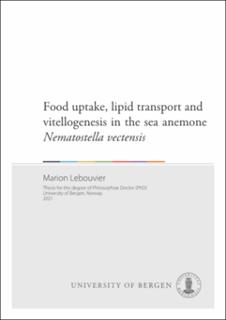| dc.contributor.author | Lebouvier, Marion | |
| dc.date.accessioned | 2022-09-23T11:35:14Z | |
| dc.date.issued | 2021-09-20 | |
| dc.date.submitted | 2021-08-30T18:50:37.017Z | |
| dc.identifier | container/de/c8/cc/f8/dec8ccf8-c878-47b7-a41b-b61c6a579a95 | |
| dc.identifier.isbn | 9788230853405 | |
| dc.identifier.isbn | 9788230848890 | |
| dc.identifier.uri | https://hdl.handle.net/11250/3020911 | |
| dc.description.abstract | Balancing energy input and output is crucial for the survival of all organisms, and involves the coordination of many physiological processes such as food uptake, nutrient storage, reproduction and growth. The uptake of food particles through endocytic mechanisms (e.g. phagocytosis, receptor-mediated endocytosis) is broadly observed and likely the ancestral mode of feeding in metazoans. However, only little is known about the biology and evolution of endocytic cell types involved in animal nutrition. Similarly, the dynamics and molecular pathways underlying the transport of nutrients is poorly investigated in animals without a circulatory system. The lack of available studies, especially in non-bilaterian animals (e.g. cnidarians, sponges) leaves a number of key questions unresolved: how did endocytic cell types evolve? What are the ancestral modalities of nutrient transport in animals? In my thesis, I address these questions by investigating the cells and molecular pathways underlying food uptake and, as a specific example of lipid transport, vitellogenesis, in the sea anemone Nematostella vectensis. By characterizing the path of food particles and dietary lipids from their ingestion to their incorporation into yolk, I aim to fill in gaps in our understanding of nutrient uptake and transport in non-bilaterians and thereby shed light on the evolution of these processes in animals.
In Nematostella, nutrient acquisition starts with the extracellular digestion of prey in the gastric cavity through secreted digestive enzymes. Using single-cell RNA sequencing (scRNA-seq), I characterized the cellular composition of the gastrodermal folds lining the gastric cavity (mesenteries) and found a high diversity of specialized gland cells expressing specific enzymatic repertoires. Extra-cellular digestion is followed by endocytosis and subsequent intracellular digestion of food particles. By using particle uptake assays, I revealed that phagocytosis and receptor-mediated endocytosis predominantly occur in specific regions of the mesenteries in Nematostella, highlighting a surprising regionalization of the anthozoan gastrodermis. These regions colocalize with the cellular expression of Nematostella orthologs of bilaterian genes typically involved in endocytosis (e.g. mannose receptor, clathrin). This strongly supports the digestive function of these cells and indicates a conserved nature of endocytic molecular pathways between cnidarians and bilaterians. These results were further validated by scRNA-seq, which revealed three distinct populations of trophic endocytes co-localizing within the endocytic region of the mesentery.
In bilaterians, dietary nutrients are most often transported towards other tissues via the circulatory system in order to be stored or to support the metabolism of peripheral tissues. Cnidarians lack a circulatory system, and the gastro-vascular cavity is thought to distribute nutrients throughout the body. The extracellular matrix (mesoglea) was previously proposed to participate in nutrient transport, but its role in this process has so far been unclear. In the present work, I describe for the first time the dynamic trans-epithelial transport of lipids from the gastric cavity into maturing oocytes located in the mesoglea in a cnidarian. Consistent with their function in shuttling lipids between the gastric cavity and the oocyte, somatic cells of the gonad epithelium also produce the glycolipoprotein Vitellogenin, a conserved yolk precursor. Gene expression data shows that the uptake of Vitellogenin into growing oocytes likely occurs through receptor-mediated endocytosis using orthologs of the vldlr/apolipophorin receptor gene family. This supports the hypothesis that a specific Vitellogenin ligand/receptor pair is highly conserved in vitellogenesis between cnidarians and bilaterians. Finally, I characterized the expression and protein localization of ApoB, a Nematostella ortholog of the bilaterian systemic lipid transport proteins Apolipoprotein-B/Apolipophorins. ApoB protein was not detected in growing oocytes in Nematostella but surprisingly localized in spermaries, suggesting a role during spermatogenesis. Overall, these results demonstrate the mesogleal transport of lipids potentially using conserved lipoprotein-lipoprotein receptor pairs in the absence of a circulatory system, and raise the possibility of a rudimentary systemic lipid transport system in Nematostella.
Altogether, my thesis revealed that nutrient uptake in Nematostella involves a remarkable diversity of specialized cell types that define functional domains in the mesenteries. The molecular machinery for food uptake, intracellular digestion and lipid transport seems to be highly conserved between Nematostella and bilaterians, providing an opportunity to elucidate the ancestral state of mechanisms underlying energy homeostasis in the last common ancestor to cnidarians and bilaterians. | en_US |
| dc.language.iso | eng | en_US |
| dc.publisher | The University of Bergen | en_US |
| dc.relation.haspart | Paper 1: Lebouvier, M., Steinmetz P.R.H. Food uptake and intracellular digestion occur via conserved endocytic pathways in specialized regions of the gastrodermis in Nematostella vectensis. The article is not available in BORA. | en_US |
| dc.relation.haspart | Paper 2: Lebouvier, M., Miramón-Puértolas P., Steinmetz, P.R.H. Conserved lipoprotein-LDL receptor pair potentially mediates lipid transport during vitellogenesis in the sea anemone Nematostella vectensis. The article is not available in BORA. | en_US |
| dc.relation.haspart | Paper 3: Lebouvier, M., Miramón-Puértolas P., Saudemont, B., Loe-Mie, Y., Marlow, H., Steinmetz, P.R.H. Single-cell atlas of the Nematostella vectensis mesentery uncovers a diversity of digestive cells and their transcriptional profiles. The article is not available in BORA. | en_US |
| dc.rights | In copyright | |
| dc.rights.uri | http://rightsstatements.org/page/InC/1.0/ | |
| dc.title | Food uptake, lipid transport and vitellogenesis in the sea anemone Nematostella vectensis | en_US |
| dc.type | Doctoral thesis | en_US |
| dc.date.updated | 2021-08-30T18:50:37.017Z | |
| dc.rights.holder | Copyright the Author. All rights reserved | en_US |
| dc.description.degree | Doktorgradsavhandling | |
| fs.unitcode | 12-60-0 | |
| dc.date.embargoenddate | 2022-09-20 | |
